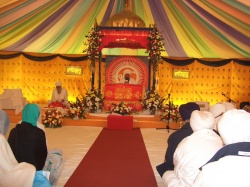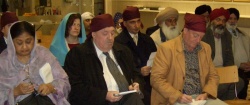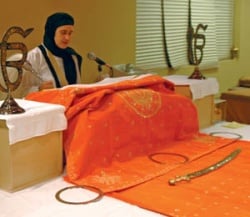Visiting a Gurdwara
Visiting a Gurdwara:

All visitors to a Sikh Gurdwara should be aware of the following guidelines when visiting:
- Please dress appropriately so that you can comfortably and with decency sit on the carpeted floor. It is recommended that all visitors to the Gurdwara wear loose fitting clothing which covers most of your legs. Low hanging or tight-fitting pants/trousers may not be suitable. Please try sitting on the carpeted floor at home for a short period to see if the clothing is suitable.
- All visitors entering the Main Prayer Hall, called the Darbar Sahib and the Dining (Langar) Hall will have to remove their shoes and place them in the shoe racks provided.
- Strictly No Smoking is allowed in the vicinity of the Gurdwara premises. Visitors cannot enter the Gurdwara while under the influence of Alcohol or Drugs. You should not take cigarettes or tobacco with you into the premises or smoke while near the Gurdwara or soon before going into the Gurdwara.
- All visitors MUST cover their heads while in the main Gurdwara areas ie: (Darbar Sahib and Langar Hall)
Head covering for men/boys will normally be available in the Gurdwara but a large knotted handkerchief is acceptable. (The Gurdwara may provide handkerchief sized cloth to cover the head). Other hats and caps (eg baseball-style caps) may not be appropriate (please check with the Gurdwara officials). Sikh men normally wear a Turban.
Women/Girls will need to wear a headscarf. The Gurdwara usually has a box of scarves, but you could bring your own headscarf for this purpose. Sikh ladies usually wear a "Chunni", which is normally a long, flowing semi-transparent plain cloth with a decorated, veiled edging.
- Chairs are not provided in the Gurdwara and so, when sitting, this will be on the carpeted floor both in the Main Prayer Hall (Darbar Sahib) and in the Langar Hall. (A few chairs may be available in the Langar Hall for visitors who have difficulty sitting on the floor due to old age or other medical conditions).
- On first entering the large prayer room (called the Darbar Sahib), a small bow to the Guru Granth Sahib (the holy book) shows respect to the host community. Backs should not be turned on the Guru Granth Sahib or the soles of the feet pointed towards the Sikh holy book when sitting on the carpet. It is normal to sit cross-legged yoga style. It may be a good idea to practise this at home if possible before your trip to the Gurdwara.
- Visitors will usually be offered Kara Parshad (sweet flour and oil based food offered as a gift) in the worship hall, which is usually given in cupped hands and eaten with the right hand. If you are uncertain about your ability to eat a lot of this food – Say “very small portion” to the Sewadar (volunteer) serving the Kara Parshad. You should take a small plastic bag (or ask for one from the Sewadar (volunteer) serving the Kara Parshad) to save your Kara Parshad if it is not to your taste – Please do not refuse it or throw it away.
- You may be offered Langar (vegetarian food from the communal kitchen). If not too certain about consuming this food you can ask to be excused although most people should take langar as it is regarded as a blessing by the Guru. When in the [[Langar Hall], it is better to ask for less rather than take too much and waste the food. Say “very little” to the Sewadar (volunteer) serving the Langar. If you require more later, just wait for the Sewadar to come around.
Personal accounts
Visit by Brian and Hunter
- Sikh and you will find - Visit to Reno Sikh Gurdwara by D. Brian Burghart
Reno Sikh Gurdwara, 1380 Selmi Drive, 327-4322, doesn’t have regular services, but the best time to visit is around noon on Sundays, when there’s a free vegetarian lunch, langar, available.
Get ready. This one is going to test my skills as a journalist because many of the concepts and words I’m describing are outside my experience. While I’ve gained a general familiarity with many different types of spiritual philosophies in the last couple of years, the Sikhs’ are new to me. I’ll strive for accuracy but apologize in advance if I spell anything wrong.
Maybe it’s appropriate that this article will not be my usual experiential tour of a facility and service, but a more informational piece, with information given to me by Harsimrat Kaur and Amolak Singh Powar, president of the gurdwara (temple), and what I found on sikhnet.com and various other internet sources.
The Sikh philosophy began in 1469 with the birth of Guru Nanak Dev Ji and became formalized in 1699 with the fifth of 10 human gurus, Guru Arjan Dev Ji, (ed: should be 10th Guru, Guru Gobind Singh) and the writing of the Guru Granth Sahib, the Sikh holy text and 11th guru of the Sikh religion/philosophy.
The core Sikh beliefs are fairly easy to state but deeply nuanced. First: “There is one supreme eternal reality: the truth, immanent in all things, creator of all things, immanent in creation. Without fear and without hatred, not subject to time, beyond birth and death, self-revealing.”
In the Sikh philosophy, all people are equal; heaven is attained through living a good life and doing good deeds; good fortune must be shared; Hukam (God’s will) is accepted; God must be praised, adherents must be humble and love everyone; the defenseless (regardless of religious affiliation) must be defended.
There are also five vices (temptations) to be avoided: Ego, sex outside of marriage, anger, greed and love of material possessions. There are also proscriptions against tobacco and intoxicants.
Is that enough background? OK, here’s a bit more. Sikh’s are often recognizable by their long hair, turbans and beards. There’s a reason for this. Each Sikh is required to wear five symbols of their faith, the Five K’s: kesh (uncut hair), kanga (wooden comb), kaccha (specially designed underwear), kara (iron bracelet), and kirpan (a small symbolic sword).
Finally, it should be noted, that most Sikhs are from the northern Indian state of Punjab, although there are members from all over the world, including one of my hosts, Harsimrat Kaur, who was born in the United States and is a converted Sikh from a Roman Catholic upbringing.
The temple was recently constructed and only opened in April. Since then, every weekend they’ve performed the Akhand Path, a continuous reading of the Guru Granth Sahib. It takes three days to read the entire scripture, and while it’s being read, there’s free vegetarian food for everyone in the large kitchen/community area.
Actually, most of the time Hunter and I visited the gurdwara, we sat in the community area with Kaur and Powar. We were asked to cover our heads and remove our shoes upon entry. The reading of the scripture by Head Priest Bakhshish Singh was broadcast on speakers and a television screen overhead.
Toward the end of the evening, we were invited into the Darbar Sahib (prayer hall), as the priest finished up, and Kaur prepared for her two-hour reading stint. When the priest finished, he brought parshad (a sweet pudding) to the people who were sitting on the floor, which we ate with our hands.
This was one of the more interesting visits for us. We knew nothing about Sikhism — by the way, it’s neither Hindu nor Muslim, but its own thing. I’d hazard a guess that many people in Reno are as ignorant about it as I was. I’d also guess that just about anyone would be made to feel as welcome as Hunter and I were in the new gurdwara.
See Also
External links
- A Visit to a Gurdwara (Place of Worship)
- Sikhnet forum - My visit to a Gurdwara
- Places of Worship in Wales by Mary Parry
- Cubs visit gurdwara Sri Singh Sabh in Hounslow
- Qualifications and Curriculum Authority - A visit to the gurdwara
Videos
Downloads
- Flyer to print out about "Visiting a Sikh Gurdwara": Download or View
- Visit to Gurdwara
- My Visit to the LaSalle Gurdwara
| Gurus: | Nanak Dev | Guru Angad | Amar Das | Ram Das | Guru Arjan | Har Gobind | Har Rai | Har Krishan | Tegh Bahadur | Gobind Singh | Guru Granth Sahib | Sikh Bhagats |
| Philosophy: | Sikh Beliefs | Simran | Sewa | Beliefs and Principles | Underlying Values | Prohibitions | Technique and Methods | Other observations | Technique and Methods |
| Practices: | Ardas | Amrit Sanskar | Chardi Kala | Dasvandh | Five Ks | Kirat Karni | Kirtan | Langar | Naam Japna | Simran | Three Pillars | Vand Chakna | Five Evils | Five Virtues |
| Scripture: | Guru Granth Sahib | Sikh Scripture | Dasam Granth | Ek Onkar | Waheguru | Bani | Mool Mantar | Japji Sahib | Jaap Sahib | Chaupai | Anand Sahib | Tav-Prasad Savaiye | Rehras | Sukhmani |
| More: | History | Gurdwaras | Harmandir Sahib | Khalsa | Khanda | Names | Places | News | Satguru | Sikhs | Bhagat Farid | Bhagat Kabir | Websites | Biographical | Terms |



